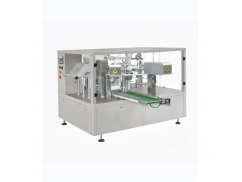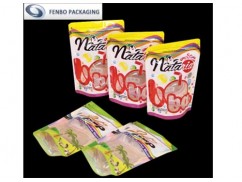How to fill stand up pouches?
Jun 17,2024 | Views: 1202
Filling stand-up pouches involves a series of steps that can be performed manually or using automated machinery, depending on the scale of your operation. Here’s a detailed guide on both methods:
- Product to fill (liquids, powders, granules, etc.)
- Funnel (for powders or small granules)
- Measuring cup or scoop
- Heat sealer
2. Open the Pouch: Expand the bottom gusset of the stand-up pouch so it can stand on its own.
3. Filling:
- For liquids: Carefully pour the liquid into the pouch using a measuring cup. You may use a funnel to prevent spills.
- For powders/granules: Use a funnel to fill the pouch. Scoop the product into the funnel, allowing it to flow into the pouch.
4. Weighing: Use a scale to ensure each pouch has the correct amount of product, adjusting as necessary.
5. Sealing:
- Ensure the top of the pouch is clean and free from any product.
- Use a heat sealer to seal the top of the pouch. Follow the heat sealer’s instructions for proper sealing times and temperatures.
Automated filling machines can significantly increase efficiency, consistency, and output. There are different types of machines depending on the product type (liquid, powder, granules) and production scale.
- Horizontal Form-Fill-Seal (HFFS) Machines: Ideal for larger pouches or when specific shapes are required.
- Auger Fillers: Used for powders and small granules.
- Liquid Fillers: Specifically designed for liquids and viscous products.
- Install and calibrate the filling machine according to the manufacturer's instructions.
- Load the roll of pre-formed pouches into the machine if using VFFS or HFFS machines.
2. Filling:
- The machine will automatically open the pouches, fill them with the product, and seal them.
- Adjust the filling parameters (speed, volume) to ensure accurate filling.
3. Sealing:
- The machine seals the pouches using heat or ultrasonic sealing methods.
- Ensure the sealing temperature and time are correctly set for your pouch material.
4. Quality Control:
- Continuously monitor the machine’s output for consistent fill levels and seal integrity.
- Regularly inspect filled pouches for defects.
- Seal Integrity: Always check the seal integrity to prevent leaks and contamination.
- Sanitization: Keep the filling area and equipment sanitized to maintain product quality, especially for food items.
- Correct Measurements: Ensure accurate measurements for consistent product quality and to avoid overfilling or underfilling.
By following these steps and tips, you can efficiently fill stand-up pouches either manually for small batches or using automated systems for larger production volumes.
Prev: How thick is a stand up pouch?
Next: What size stand up pouch do I need?
Manual Filling
Materials Needed:
- Stand-up pouches- Product to fill (liquids, powders, granules, etc.)
- Funnel (for powders or small granules)
- Measuring cup or scoop
- Heat sealer
Steps:
1. Preparation: Ensure your work area is clean and sanitized. Have all your materials and tools ready.2. Open the Pouch: Expand the bottom gusset of the stand-up pouch so it can stand on its own.
3. Filling:
- For liquids: Carefully pour the liquid into the pouch using a measuring cup. You may use a funnel to prevent spills.
- For powders/granules: Use a funnel to fill the pouch. Scoop the product into the funnel, allowing it to flow into the pouch.
4. Weighing: Use a scale to ensure each pouch has the correct amount of product, adjusting as necessary.
5. Sealing:
- Ensure the top of the pouch is clean and free from any product.
- Use a heat sealer to seal the top of the pouch. Follow the heat sealer’s instructions for proper sealing times and temperatures.
6. Quality Check: Inspect the seal to ensure it is airtight and check the pouch for any leaks or defects.
Automated Filling
Automated filling machines can significantly increase efficiency, consistency, and output. There are different types of machines depending on the product type (liquid, powder, granules) and production scale.
Types of Machines:
- Vertical Form-Fill-Seal (VFFS) Machines: Suitable for a wide range of products and often used for high-speed operations.- Horizontal Form-Fill-Seal (HFFS) Machines: Ideal for larger pouches or when specific shapes are required.
- Auger Fillers: Used for powders and small granules.
- Liquid Fillers: Specifically designed for liquids and viscous products.
Steps:
1. Setup:- Install and calibrate the filling machine according to the manufacturer's instructions.
- Load the roll of pre-formed pouches into the machine if using VFFS or HFFS machines.
2. Filling:
- The machine will automatically open the pouches, fill them with the product, and seal them.
- Adjust the filling parameters (speed, volume) to ensure accurate filling.
3. Sealing:
- The machine seals the pouches using heat or ultrasonic sealing methods.
- Ensure the sealing temperature and time are correctly set for your pouch material.
4. Quality Control:
- Continuously monitor the machine’s output for consistent fill levels and seal integrity.
- Regularly inspect filled pouches for defects.
Tips for Successful Pouch Filling
- Product Compatibility: Ensure the product and the pouch material are compatible, especially for food products.- Seal Integrity: Always check the seal integrity to prevent leaks and contamination.
- Sanitization: Keep the filling area and equipment sanitized to maintain product quality, especially for food items.
- Correct Measurements: Ensure accurate measurements for consistent product quality and to avoid overfilling or underfilling.
By following these steps and tips, you can efficiently fill stand-up pouches either manually for small batches or using automated systems for larger production volumes.





